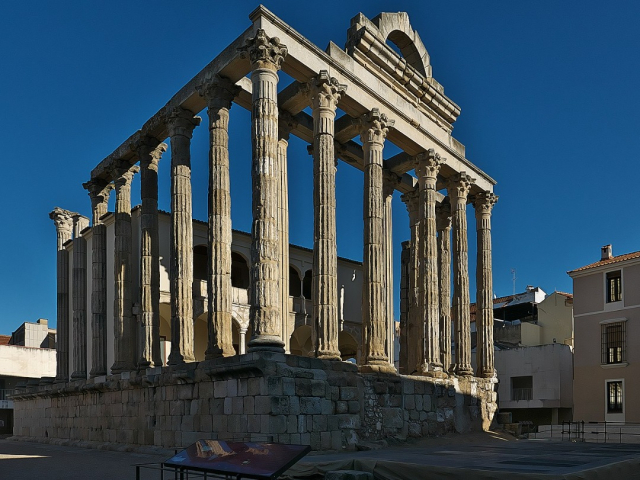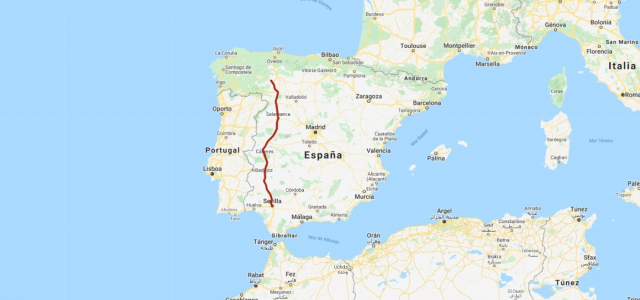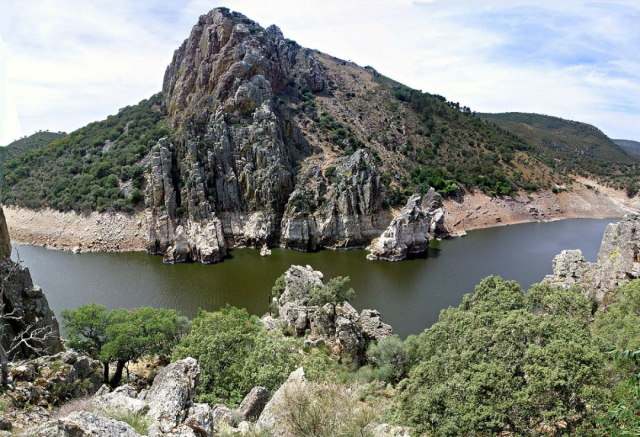Vía de la Plata: Map + Complete Guide with stages
The Vía de la Plata takes us through some of the most important monumental cities of the peninsula for 700 km, from Seville to Astorga, passing through Mérida or Salamanca.
What is the Vía de la Plata?
The Vía de la Plata is an ancient Jacobean route of 700 kilometers divided into 27 stages. Also known as the Silver Route, it links the southwest of the peninsula with the northwest, starting from the city of Seville and crossing six Spanish provinces to the city of Astorga in Leon. The road we know today is based on a set of Roman roads thousands of years old, as they originally linked the settlements of Emerita Augusta (capital of Lusitania) and Austriaca Augusta.
It was the most important communication route in all of western Spain during the Roman Empire. Centuries later, the Vía de la Plata was used both for the Muslim conquest of the Iberian Peninsula and for the Christian reconquest of the peninsular territories. With this long series of events, it would finally be the Christian pilgrims who would use these Roman roads to travel north to visit the remains of the Apostle in Santiago de Compostela.
Camino de la Plata: Origin of its name
It might seem that the name of this route is linked to the silver trade, but it may not be. There are other theories of the origin of the name of the Vía de la Plata. Due to the Arab influence in Andalusia, one theory is that its Arabic etymology is “balath”, which means “paved road”. Another theory comes from late Latin, according to which it would be called "via delapidata", which means "paved public road".
Both meanings have a similar meaning, although historians generally opt for the phonetic change from the Arabic word. We must also consider that it may have a literal meaning and that it was the route used to trade silver, although this does not coincide with the Roman origin of the road.
Historically, pilgrims arriving north had to decide whether to continue to Astorga and take the French Way or deviate through the interior of Galicia through what is now known as the Camino Sanabrés. However, the Vía de la Plata has not only been used to visit the tomb of Santiago el Mayor, but also to trade silver, according to one of the theories of the origin of its name.
The silver came from America to the port of Seville and from there it was distributed throughout the peninsula. The Ruta de la Plata is also currently a road of Roman origin that passes through Mérida, Salamanca and Astorga.
Why choose the Silver Route to do the Camino de Santiago?
The Vía de la Plata is a unique route that crosses the peninsula from south to north, passing through some essential monumental cities such as Seville, Merida, Salamanca or Astorga. Thanks to this, it transmits a Jacobean experience that is very different from the rest of the routes. It is loaded with multiple historical and cultural heritage, without forgetting the incredible landscapes full of nature, the tradition of different populations, etc..
It is one of the most demanding routes, with some of the longest stages of the whole Camino de Santiago that will load our legs with kilometers and with really high temperatures between the months of June and September. Although it is not at all advisable to walk the Vía de la Plata in summer due to the extreme heat of the south, the spring months are perfect for immersing yourself in these ancient routes and even with the fall of the leaves in autumn.
What to see during your trip along the Vía de la Plata?
As we mentioned before, this is a route with an impressive natural heritage. Pilgrims can visit such impressive places as the National Park of Monfragüe or the Natural Park of Lago de Sanabria, among others.
In addition, in it we can see remains of many of the civilizations that once settled in the Iberian Peninsula. These range from the Roman vestiges that can be found in the city of Merida, to impressive cathedrals such as the one in Astorga, to buildings from the Andalusian period in Seville, such as the Torre del Oro and the Alcazar.
Peculiarities of the Vía de la Plata
This route has unique characteristics that must be taken into account if it is our option to go to Compostela. The first thing to keep in mind is that, in this case, it will not be a good idea to take advantage of the summer holidays to do the Camino here. In summer, especially in July and August, temperatures can be extreme, so it is better to take advantage of the more pleasant months. It is an ideal route to do in spring or autumn.
Although its length makes this route demanding, it presents very little unevenness in the stages, at least until it connects with the Camino Frances. This makes it accessible in difficulty for everyone, although the accumulated wear and tear will be higher than in other shorter routes.
The Vía de la Plata is the longest route on the Peninsula, covering a total of almost a thousand kilometers between Seville and Compostela. It crosses eight provinces and about 100 municipalities, although it can be longer due to the distance between them for much of the way.
What to eat and where to sleep on the Silver Route?
Although it is not one of the busiest routes, at least if we compare it with the French or Northern Way, it has a good number of pilgrim hostels with plenty of availability. Most of them are open all year round. In addition, pilgrims have many other accommodation options.
As for the gastronomic section, pilgrims will have the opportunity to taste the wide variety of typical dishes of the different regions they visit. We can find dishes such as huevos a la flamenca, migas from Extremadura, hornazo from Salamanca or cocido maragato.
All the stages of the Silver Route
The Vía de la Plata crosses the entire peninsula starting in Seville and ending in Astorga. After 700 kilometers divided into 27 stages, it joins the French Way.
- Stage 1: Seville - Guillena (22.7 km).
- Stage 2: Guillena - Castilblanco de los Arroyos (17.5 km)
- Stage 3: Castilblanco de los Arroyos - Almadén de la Plata (29.3 km)
- Stage 4: Almadén de la Plata - Monesterio (34.5 km)
- Stage 5: Monesterio - Fuente de Cantos (21.6 km)
- Stage 6: Fuente de Cantos - Zafra (24.6 km)
- Stage 7: Zafra - Villafranca de los Barros (19.2 km)
- Stage 8: Villafranca de los Barros - Torremejía (27 km)
- Stage 9: Torremejía - Mérida (16 km)
- Stage 10: Mérida - Alcuéscar (36 km)
- Stage 11: Alcuéscar - Cáceres (38.2 km)
- Stage 12: Cáceres - Alcántara Reservoir (33.4 km)
- Stage 13: Alcántara Reservoir - Grimaldo (20.9 km)
- Stage 14: Grimaldo - Carcaboso (30.8 km)
- Stage 15: Carcaboso - Aldeanueva del Camino (38.6 km)
- Stage 16: Aldeanueva del Camino - La Calzada de Béjar (22.2 km)
- Stage 17: La Calzada de Béjar - Fuenterroble de Salvatierra (20.2 km)
- Stage 18: Fuenterroble de Salvatierra - San Pedro de Rozados (28.6 km)
- Stage 19: San Pedro de Rozados - Salamanca (23 km)
- Stage 20: Salamanca - El Cubo de la Tierra del Vino (36,4 km)
- Stage 21: El Cubo de la Tierra del Vino - Zamora (31.8 km)
- Stage 22: Zamora - Montamarta (18.6 km)
- Stage 23: Montamarta - Granja de la Moreruela (22.9 km)
- Stage 24: Granja de la Moreruela - Benavente (27.2 km)
- Stage 25: Benavente - Alija del Infantado (20.5 km)
- Stage 26: Alija del Infantado - La Bañeza (22.1 km)
- Stage 27: La Bañeza - Astorga (24,2 km)
Continue along the French Way to Santiago de Compostela
Keep in mind that, in addition to the typical yellow arrows, on the Camino de la Plata there are other signs, with granite blocks and colored tiles. If the tile is yellow, it indicates that the road is passable, although it does not match the original route. If it is green, it means that it is the original route of the Roman road, however, it is not completely consistent with the Jacobean route. For this reason, it is necessary to pay close attention when choosing the correct direction to Santiago de Compostela.
Related
Routes
Blog
 How to get to Sarria to do the Camino de Santiago
How to get to Sarria to do the Camino de Santiago
 Descubre la magia del Camino de Santiago Portugués por la costa
Descubre la magia del Camino de Santiago Portugués por la costa
 5 tours culturales que puedes hacer en Galicia si decides hacer un alto en el camino
5 tours culturales que puedes hacer en Galicia si decides hacer un alto en el camino
 Doing the Camino de Santiago in June: What you should know?
Doing the Camino de Santiago in June: What you should know?
Information
Points of interest
Cities & Towns | Hostels | Lodgings | Restaurants | Saddlery | Doctors | Points of interest | Bikes workshop
Contact us | Privacy policy | Cookies policy | | Terms of use | Authorship | Web Map | Consentimiento
© Copyright LA VOZ DE GALICIA S.A. Polígono de Sabón, Arteixo, A CORUÑA (ESPAÑA) Inscrita en el Registro Mercantil de A Coruña en el Tomo 2438 del Archivo, Sección General, a los folios 91 y siguientes, hoja C-2141. CIF: A-15000649
Developed and managed byHyliacom


